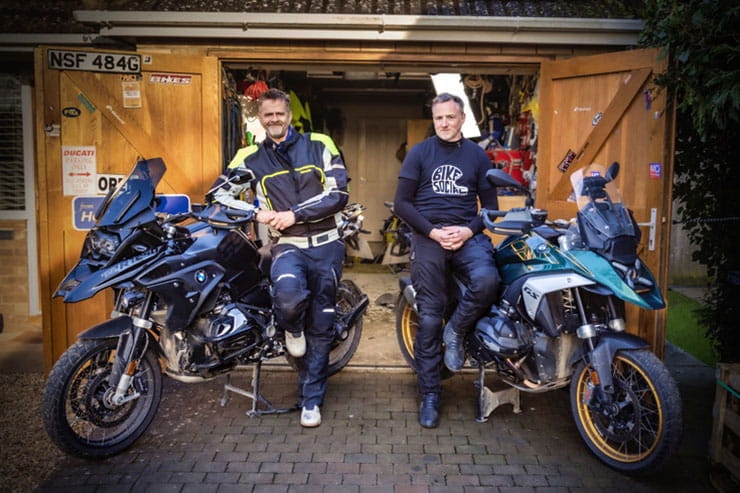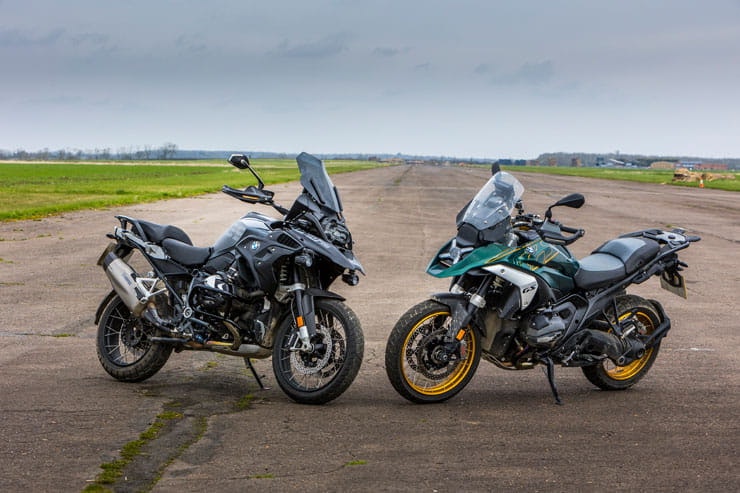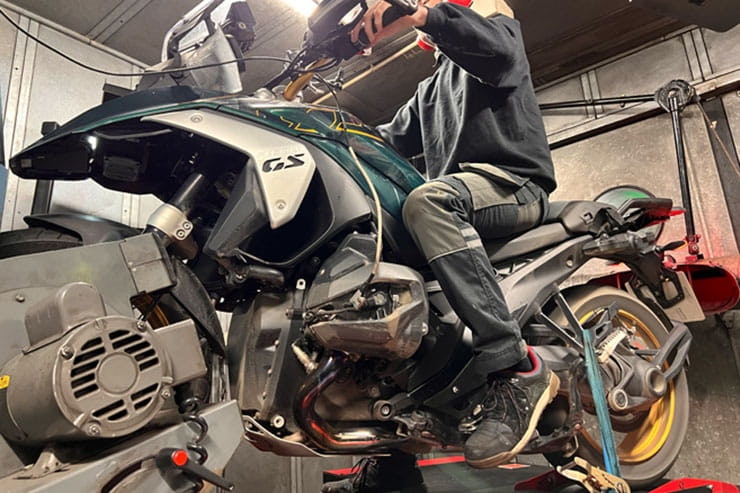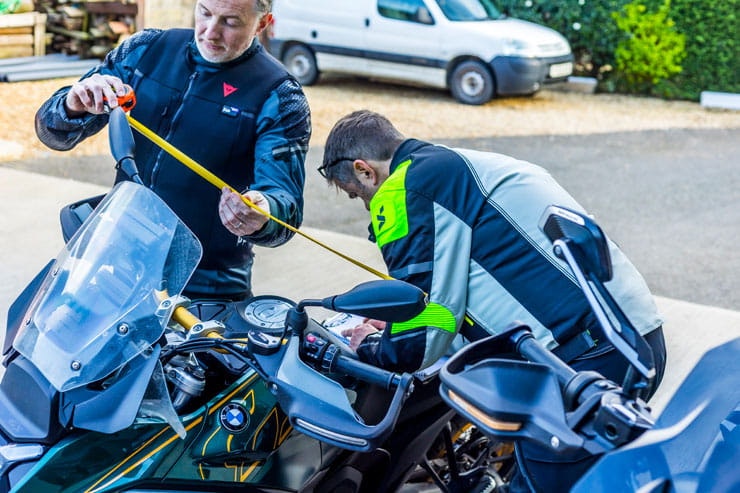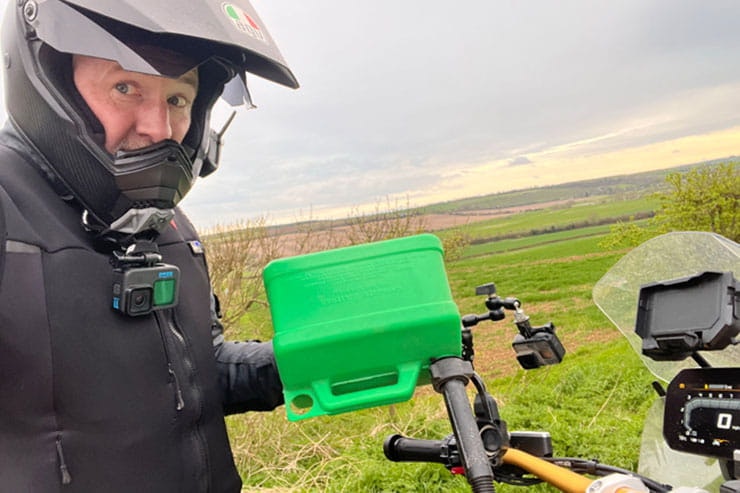BMW R1300 GS (2024) vs BMW R1250 GS (2023) - Dyno, Speed & Road Test
BikeSocial Road Tester
09.04.2024
With a completely revamped and enlarged engine, a new type of frame, uprated suspension and ergonomics and – controversially – a total styling makeover, few bikes have been as widely discussed and dissected as BMW’s 2024 R1300 GS. You can’t have missed it, from the well-publicised launch last autumn to innumerable YouTube videos and magazine features. And with good reason – re-inventing and potentially re-positioning the most popular big bike of the last 20 years is a significant motorcycling event. Not to mention a big risk for BMW.
But we here at BikeSocial wanted to wait for the swirling cloud of hype-dust to settle before we take a bit more time to evaluate what BMW have done to create the R1300, to compare it properly to its predecessor, the R1250 GS, and to work out in which direction BMW have taken it.
Bike tests are a mix of the objective – stuff we can measure, like power and torque, acceleration, top speeds, ergonomics, weight, fuel economy – and the subjective – how does all that ‘feel’ to a rider? So to evaluate the 1300 and compare it to the 1250, we’re going to dyno them both, speed test them, measure their weight and riding positions, ride them for a couple of hundred miles and run them dry to measure their fuel consumption. Pillion comfort and off-road ability are beyond the scope of this test; we’ll be testing the 1300 with a pillion at a later date. Also, we’re assuming you’ve already absorbed the bulk of the technical changes to the 1300 over the 1250 – what BMW have done to the engine, frame and general chassis; if not, this is our Technical Review.
After all that, we should have a clearer idea of what the R1300 GS is, what it does better than the R1250 GS... and maybe what it does worse.
So without further ado, let’s get stuck into the testing...
BMW R1300GS vs R1250GS: the ULTIMATE test
The latest GS is a completely new model so we pitch it against its sales chart dominating predecessor on the dyno, on a runway, with a full tank of fuel, and more.
R1300 GS v R1250 GS power and torque dyno test
BMW claim the 1254cc 1250 GS makes 134bhp @ 7750rpm, and the 1300cc R1300 – with more capacity from wider bores, shorter stroke, plus higher compression and larger intake and exhaust valves – is said to make 143bhp @ 7750rpm. That’s a claimed 9bhp more.
Torque figures are also improved: the 1250 claims 105 lb.ft @ 6300rpm and the 1300 110 lb.ft @ 6200rpm.
These figures are what BMW claim for the engines measured at the crank – and they’re normally pretty accurate. Over 30 years’ experience putting test bikes on the dyno, we know that shaft drive losses normally sap around 10-12% of the engine’s output, depending on the manufacturer and the design of the shaft drive and transmission. If the 1250 is claimed to make 134bhp at the crank, we’d expect it to make 118-120bhp at the wheel – and it does, losing around 11% between crank and rear wheel.
The 1300 however, has a redesigned shaft drive BMW say reduces losses thanks to a reduced deflection angle, and which also harmonizes the natural fluctuations in shaft rotation present in a flat twin. The result is a mere 6% loss between crank and wheel; this is the sort of loss we’d expect with chain drive, so it’s a major step forward in delivering greater engine efficiency – literally, more bang for your buck at the back wheel.
The actual measured power and torque figures are:
R1300 GS
134bhp @ 7750rpm
104.4 lb.ft @ 6200rpm
R1250GS
120.0bhp @ 7600rpm
97.3 lb.ft @ 6300rpm
In terms of comparing the two engine outputs, the 1300 has more power and more torque everywhere, as you’d expect with increased capacity. It’s particularly strong between 3000rpm and 4500rpm – a useful part of the rev range to have more grunt – and from 6000rpm upwards. BMW have resisted the temptation to allow the shorter stroke, wider-bored, more-oversquare 1300 to rev harder than the 1250 – perhaps saving that extra performance for a model upgrade two or three years from now. It certainly has the capacity to do it (boom tish).
The only slight reservation about the 1300’s power curves is the severity of the dip at 5000rpm – torque drops quite steeply (more severely than the dip in the 1250’s curve at the same point), before rising again more steeply to its peak. This is, in effect, a relatively deeper trough in the curve (still making more than the 1250 though) which, although unnoticeable on the road, might contribute to the 1300’s performance in speed testing later on.
Taking a peek inside the motors, both engines are obviously flat twins – but the 1300 is a wholescale redesign and repackaging. The transmission is relocated under the engine instead of behind it, but a fairly astonishing miniaturisation and efficient use of space sees it take up far less room, meaning the 1300 motor is barely taller, if at all, than the 1250 – and is considerably shorter. The reduced stroke also means the width of the engine is reduced. Naturally, this means new pistons, rods, crank, gearbox, clutch, generator, crank cases, cylinder heads – every component is new. BMW claim the 1300 motor saves a colossal 3.9kg just in the basic engine, and 6.5kg less including transmission and ancillaries. It’s hard to tell if that means the 1250 was a poor design, or the 1300 is incredible, or if one’s built of metal and the other tinfoil. But BMW have had four years to test the arse off the engine, so you’d assume they haven’t shaved too much off.
The 1300’s cylinder heads and valvetrain layout are also redesigned. Both engines share a Shiftcam system, which switches between milder and wilder intake cam lobe profiles depending on engine speed and throttle position, for increased emissions control. But there are further changes to the R1300 GS cylinder heads besides larger valves, new springs and revised cam timing – in each 1250 cylinder, a camchain turns a central intermediate gear, which spins the intake and exhaust cams. In the 1300, the intermediate gear is removed and the cam chain runs around a pair of conventional cam sprockets. This allows the cylinder head width to be reduced with shorter camshafts – and the intake cam now runs on two bearings instead of the 1250’s three.
All this could account for reports of increased mechanical noise from the R1300’s top end – noise which the 1250’s new Hy-Vo camchain reduced over its roller-chain predecessor, the 1200. With an intermediate gear, the 1250 cams contra-rotate; in the 1300, the cams spin in the same direction. And in a further change, the 1250’s camchains run to the rear of both cylinders – the 1300 runs one camchain to the front of the right cylinder (as seen sitting on the bike), but the left cylinder’s camchain runs to the rear of the left cylinder. It’s a small reminder of the flat twin’s natural asymmetry, even if its headlight is now symmetrical!
R1300 GS v R1250 GS performance testing, 0-60, top speed and braking
To help speed test the R1300 and 1250, we enlist the services of ace performance tester Bruce Dunn – a man with a datalogger and over 30 years’ experience thrashing bikes up and down a runway, round tracks and occasionally up and down Autobahns in between snow flurries. If there’s a mechanical device with two wheels and an engine, chances are Bruce has ridden it flat out.
We plan to measure the following:
1) Absolute top speed
2) 0-60mph times
3) 0-100mph times
4) Standing quarter mile times with terminal speeds
5) 40mph-70mph roll-on times and distances in fourth gear
6) 40mph-70mph roll-on times and distances in sixth gear
7) Braking from 70mpm to 0mph in distance
8) Engine speed (rpm) in:
a) 30mph in 1st gear
b) 40mph in 2nd gear
c) 50mph in 3rd gear
d) 60mph in 4th gear
e) 70mph in 5th gear
f) 80mpg in 6th gear
Bruce carries out the test under as near-identical conditions as possible, on the same day, one bike after another, always in the same directions on each bike. He repeats most of the tests several times to achieve an optimal result for each bike.
Although these tests shouldn’t be compared to results achieved on different days, at different locations, with different riders in different weather conditions, they *are* comparable with each other. The bikes are carrying slightly different fuel loads, but the weight difference is a few kilos and do not impact the test figures.
Results
(red is faster/better)
The performance figures between the bikes are fairly close – which shows just how much more horsepower (or better aero) you need to make a significant improvement in what you’ve already got. The most obvious difference is the 1300’s top speed figure – it’s 8mph faster than the 1250. The main factors here are peak power, gearing, aerodynamics and, most importantly these days, what the manufacturer *allows* the bike to achieve (usually by limiting with electronics). That the 1300 reaches a higher top speed than the 1250 is probably as much down to BMW’s software as much as 14bhp and sleeker aero (although it helps).
And adventure bike top speeds are academic – not even schoolkids are impressed these days. What’s more important to riders on the road in terms of performance comparisons are the bikes’ nimbleness off the line at traffic lights, engine flexibility and roll-on performance for overtakes, and braking efficiency.
On general acceleration, the R1300 is quicker – but not by much. It takes just over three seconds for both bikes to hit 60mph. The 1250 records a slightly better time, but only by three hundredths of a second – it could be put down to slightly longer gearing in first and second making the launch easier, but in reality it’s easily within the margins of repeatability error, even for a rider of Bruce’s calibre. But by 80mph the 1300 starts to edge in front, and above 100mph it’s pulling clear.
More relevant to road riding, the roll-on times and distances are more revealing. Simulating an overtake from 40mph to 70mph in fourth gear, the 1300 is marginally faster than the 1250 – making its bigger engine and weight advantage count. But in top gear it’s the other way round – the slightly shorter-geared 1250 will move its bulk quicker than the 1300 between 40 to 70mph to the extent that if they started from the same position behind a vehicle at 40mph, by the time both bikes hit 70mph the 1250 rider would be seven metres ahead of the 1300.
Under crash braking from 70mph, both bikes get into ABS operation at around 50mph – but by then the lighter, lower 1300, with 310mm discs and revised four-pot radial calipers over the 1250’s 305mm discs and four-pot radials, is already stopping more sharply, hauling the bike up four metres short of the 1250. If four metres doesn’t sound much, when the 1300 is stopped the 1250 is still travelling at just under 20mph – fast enough to hurt if it hits something solid.
Gearing – revs in gears at increasing road speeds
(red is more revs, blue is lower revs)
This test shows the real-world effect of gearing differences between the bikes – the 1250 has longer gearing in the first two gears, they’re about the same ratios in third and fourth, and in fifth and sixth the 1300 GS is slightly longer.
This translates into a marginally more relaxed engine pace in top gear at cruising speeds – it’s not by much, but the 1300 definitely has a calmer, less busy feels to the engine at cruising speed – and its gearing is one of the reasons why.
R1300 GS v R1250 GS riding position, seat height & weight
Before we get into the subjective side of rider comfort on the old and new GS, it’s worth checking the dimensions we’re working with. Never mind performance numbers and engine output; how does the new R1300 GS differ from the 1250 when you whip out the tape measure and compare their ergonomics?
We find our figures broadly agree with BMW’s claimed stats, so for the most part we’ll quote the figures BMW claim and deviate only when we differ or have alternative information.
Both bikes have adjustable seat heights, after a fashion. The 1250 GS has two official seat heights, with reversible seat adjusters at the front and rear of the seat (technically this gives 6 permutations of seat position, but only two variable heights) giving either 850mm or 870mm. The R1300 has a fixed position seat set at 850mm, but if the new GS is fitted with BMW’s adaptive vehicle height control (available only in conjunction with DSA semi-active suspension) the seat height will automatically drop to 820mm as the bikes slows down and at standstill. On engine off, we measure the bike dropping another 10mm. A 1300 GS equipped with adaptive height control can be set to auto (it automatically changes seat height), permanently high or permanently low.
In practice, we measure the R1300 seat height as around 10-15mm lower than the R1250 in both low and high settings – and it’s important to note that when the R1250 seat height is on high, it also increases the distance between the seat and the footpegs (effectively opening out hip and knee angle, giving more legroom), going from 500mm to 520mm. The R1300’s seat-to-peg distance remains the same 510mm regardless of seat height because the two move up and down relative to the ground.
We measure the R1300 footpegs at the same height as the R1250, but rear-set relative to the natural seating position by around 15mm. This opens out the hip angle, but compresses the knee angle.
We measure the handlebars at the same 910mm from end to end, but the R1300’s are 20mm higher than the R1250’s relative to the ground, and very slightly further forward. This has the effect of tilting the rider forward slightly (especially the head) and makes the R1300 riding position feel sportier, pulling the rider towards the front of the bike. This, in turn, has the effect of making the rider feel as if the bars are actually closer on the 1300, not further away. It also makes the width of the bars feel less natural.
The bikes have very different wind management. The R1300 features an electrically adjustable screen while the 1250 has a manual adjuster. The screen on the 1300 is taller at its lowest and highest settings, and has a steeper angle which forces wind higher over the rider’s head. The 1300 also has wide side deflector pods.
The dash display is one of the few things the bikes share, with identically sized units. But they’re in a different position – the 1300’s is significantly higher and closer to the rider, making it easier to read.
BMW claim the 1250 weighs 249kg and the 1300 weighs 12kg less at 237kg, fully fuelled. Both bikes are in a non-standard condition; the 1300 is a TE edition (mostly adding software but with some associated components and wiring, wire rims, then also adding Dynamic and Touring Pack hardware such as GPS, pannier fastenings and handguards). It also has Option 719 extras included in the Tramuntana Pack, some of which add a few grams. It brings the bike’s total weight to a measured 250kg – 13kg more than BMW claim.
The 1250, also in TE Triple Black spec, adds weight of its own with engine bars, wire rims, fog lights and Option 719 extras etc – we weigh it at 260kg. In 2019 we weighed the 1250 GS, also in TE spec but without the Option 719 kit, at 258kg. So our 2024 1250 is 11kg more than BMW claim for the stock bike – and we reckon that’s about right.
And it means the in the spec we have the bikes, the 1300 is 10kg lighter than the 1250.
R1300 GS v R1250 GS road riding impressions & fuel economy
Right, enough of the measuring; let’s ride. Both myself and BikeSocial’s Michael Mann set out to cover around 200 miles on a loop that runs up across Lincolnshire’s Wolds, drops down along the A1, then picks up the Rutland TT and passes in a loop through Market Harborough and Melton Mowbray. It’s a great ride on a mix of swooping A-roads and tight back-road Bs, perfect for assessing the real-world engine performance, handling dynamic, ride comfort and ride quality, and fuel economy of both bikes.
Michael and I ride at together, swapping bikes at regular intervals to average out small variations in riding style that might influence fuel consumption. We start the bikes off with full tanks of fuel with a 5-litre fuel can strapped to the back. We want to run the bikes dry to find out not just fuel consumption and how far they go to reserve, but also how far they’ll go past 0 miles on the remaining range indicators. And then how big the tanks really are when we refill them!
The weather conditions are mostly dry with some patches of wet road from overnight rain – and an awful lot of mud dropped by farm traffic – some in great clods, some smeared into the road. It’s a good test of the bikes’ roadholding. Both are on Michelin Anakee Adventure tyres, to make the comparison as fair as possible.
The R1300 GS immediately is the fitter, lighter, sportier, more active and athletic of the pair. It’s more compact, physically smaller (but not cramped), more agile, faster and more willing to crack on. It’s a natural continuation of the way the 1250 felt compared to the 1200 – only more so. The engine spins up faster and is more responsive than the 1250 – the already imperceptible connection between opening the throttle and the motor responding is reduced still further, crucial milliseconds and milligrams making an intuitive, almost subliminal set of improvements that cumulatively make the 1300 come alive in your hands – while the 1250, comparatively, has a default that feels more relaxed, less hurried and less keen. Which of course isn’t to say it can’t be boogied – the 1250, like every GS since 2004, can be bundled along at a hugely improbable rate. But the key is the word ‘bundled’ – you don’t have to bundle a 1300 GS; it’s up for it as much as you are (or might be if the mood takes you).
If all this makes the 1300 sound a bit too much like a sportsbike – relatively speaking, again – then I suppose it kinda is, really. The GS (in 1300 guise; what the GS Adventure will feel like is anyone’s guess) is now bridging the gap between BMW’s S1000 XR series and GS world. If the XR was a GS with an inline four, the 1300 GS is getting closer to an XR with a flat twin. And, depending on your predilection for pace, that’s not a bad thing. It’s very similar to an R1300 RS sports tourer with higher bars and better wind protection. Think on that.
And it’s not to say the 1300 GS can only be sportier than the 1250. It can also do more civilised – it’s not as revvy, and feels smoother and less frantic at cruising speed. And it’s also more efficient – contrary to BMW’s own claimed fuel consumption figures, the 1300 – for our purposes – returned better mpg than the 1250.
BMW claim crazy numbers – manufacturers always do, because emissions regs state they have to back-calculate fuel consumption figures from measured exhaust emissions – and they bear as much relation to the real world as a teenage fantasy of Michelle Pfeiffer and a vat of Marmite (it was a long time ago but the memory lingers). Anyway, BMW’s claim for the 1300 is 58.9mpg and the 1250 is 59.5mpg. So yes, they claim the 1250 is marginally more efficient.
But that’s not what we found, nor what the bikes themselves thought. Here’s our fuel data:
It shows clearly that the R1300 engine is more fuel efficient than the R1250 GS engine, and as good as compensates for having a two-litre deficit.
It also shows the 1300’s 19-litre tank carries the bike over 50 miles from its reserve fuel warning to completely, you’re-now-pushing-mate, empty (worth knowing). And the 1250, with its slightly larger-than-advertised 21-litre tank, will plod on for nearly 60 miles from the reserve panel. Awesome info imo. Insert gag about electric bikes here.
To sum the motor up, I can’t think of a reason why anyone would prefer the 1250 engine to the 1300 – the bigger unit is superior in every respect, from outright performance, to efficiency, to feel, to real-world performance. Some people have pointed out the top end is noisier than the 1250 – can’t say I noticed, although I wasn’t listening out for it. But it wasn’t different enough to make me aware – to be honest, I have music on most of the time in my earbuds, so I wouldn’t hear the engine anyway! I suggest anyone concerned about a top end rattle should just chuck their favourite Spotify playlist on, et voila! It’ll be gone!
The 1300 engine’s willingness (and size) informs its chassis dynamic. The 1300 is more agile, playful, confident and controlled. It steers with more confidence, less weight transfer and more accuracy – more like a sports tourer, hem hem – and has probably about the least ‘adventure’ chassis of any adventure bike I’ve ridden. Maybe it’s a 2024 thing, what with Honda’s Africa Twin Adventure Sport and its new, road-biased 19in front... the year adventure bikes truly become sports tourers on very short stilts.
Because the 1300 chassis performs the same trick as its engine: despite weighing less and having more compact – and therefore more accessible – dimensions, it’s also got longer suspension travel, which is good for ride quality (and yes, the 1300 handles bumps more competently than the 1250) as well as bigger brakes for better stopping, and more accommodating aerodynamics. All this isn’t really a subjective opinion you can disagree with – we measured it; it’s a bunch o’ facts. Don’t blame us.
Comfort is something we can argue about. Ish. With its ’leccy screen pinging up almost vertically and a wide pair of side deflectors (which may or may not be part of the extras package; it’s hard to tell what’s standard and what isn’t with a BMW, but it’s safe to assume anything remotely useful costs extra), the 1300’s wind deflection is superior to the 1250 and, I suggest, better than any other adventure bike. BMW have done their aero homework, and it works. No buffeting, less noise, and I can even hear Marillion’s quiet bits. It’s annoying to have to fiddle about with allocating screen adjustment to the same button as the heated grips and seat every time you want to adjust it – ‘favourites’ buttons are all very well until you realise you have more than one ‘favourite’ function. And, while we’re complaining, for over £20k you’d thunk BMW would make the switches backlit so you could see them at night and not have to rely on the headlight of someone behind you. Which actually happened (on a different ride).
Michael and I disagreed on the 1300’s riding position comfort – Michael found the wide bars felt a little too far away and they strained his (admittedly dicky, from an old war wound) shoulders and upper back. I had no such problems, but I always feel GS bars are too wide to be as comfy or natural as they could be. I also felt the seat was comfy, but not as figure-hugging as the current holder of “Motorcycling’s Comfiest Seat”, Suzuki’s V-Strom 800 DE.
Compared to the 1300, the 1250 is larger, rangier, roomier, spacier, vastier. It has more mass literally and spiritually – when you approach the bike, it looks as if the BMW means it. The 1300 looks like Honda means it (but let’s not get into styling – that really is a personal choice).
R1300 GS v R1250 GS Verdict
Almost any way you measure it – and I stress the word ‘measure’ – the 1300 is a superior machine to the 1250. It’s a major step forward in engine compactness if not outright performance (maybe that comes down the line in a few years). Similarly, the 1300 handles and tours and just exists in a physical space beyond the 1250 design. It’s actually a different kind of bike, moving out of adventure bike territory and into more of a Multistrada, all-round role. Which, in truth, is what it’s mostly always been used for by owners – but what riders feel like they could do and what they actually do have always been two different things.
Of course that doesn’t necessarily make it the bike you want to upgrade to if you’ve got a 1250, or 1200 GS. Or maybe even an 1150, if you love it, you filthy pervert. That depends on a lot more than a tape measure, datalogger and dyno. For a start there’s the price – the 1300 GS in these pics costs £23k – and so does the 1250 in tested spec. When incomes for many of us have hardly been keeping pace with that snail over there, more than £20k for a bike is having a giraffe. I can’t even scrape together £3k to buy a 20 year-old R1200 RT (which, as it happens, I’d much rather own than a new R1250 RT, for many of the weird reasons we’re going on about).
BMW have plunged headlong into the same bucket of eels currently troubling Harley-Davidson and Moto Guzzi. All three build and sell bikes specifically with a quirky, leftfield appeal – and in BMW’s case, it happens so many riders had a resonance with the GS Boxer twin it became the best-selling big bike in the world for the last 20 years etc. Christ, imagine if Ewan (something of a Moto Guzzi fanatic) had chosen a Stelvio or a V85TT to go round the world (if they’d built them back then).
Anyway, the 1300 and the 1250 are such different machines, it’s entirely within the bounds of civilised behaviour to prefer the older bike to the newer one. Plenty of reasons – almost none dynamic, but just as valid whatever they are. I suspect that as well as unquestionably improving the 1300’s physical prowess, BMW’s stylistic and functional shift to the centre-ground risks alienating a lot of riders who love the GS *because* it’s a bit out there; you can’t squint and mistake a 1250 (or any other GS) for being built by anyone else. With the 1300, however, it’s so refined and homogenised it could plausibly be built by someone like Honda. And that could be a potential weakness. First year sales will be incredible – but if I were Ducati or Triumph, right now I’d be getting something on the drawing board that has half a chance of capturing that leftfield popularity.
So there it is, after much banging on: the R1300 GS is a better bike than the R1250 GS by, depending how you measure it, quite a lot, some, or a bit. But would you prefer it to a 1250 GS? Not necessarily.
If you’d like to chat about this article or anything else biking related, join us and thousands of other riders at the Bennetts BikeSocial Facebook page.
R1300 GS v R1250 GS Specification
Looking for motorcycle insurance? Get a quote for this motorbike with Bennetts bike insurance
What is MCIA Secured?
MCIA Secured gives bike buyers the chance to see just how much work a manufacturer has put into making their new investment as resistant to theft as possible.
As we all know, the more security you use, the less chance there is of your bike being stolen. In fact, based on research by Bennetts, using a disc lock makes your machine three times less likely to be stolen, while heavy duty kit can make it less likely to be stolen than a car. For reviews of the best security products, click here.
MCIA Secured gives motorcycles a rating out of five stars (three stars for bikes of 125cc or less), based on the following being fitted to a new bike as standard:
A steering lock that meets the UNECE 62 standard
An ignition immobiliser system
A vehicle marking system
An alarm system
A vehicle tracking system with subscription
The higher the star rating, the better the security, so always ask your dealer what rating your bike has and compare it to other machines on your shortlist.
